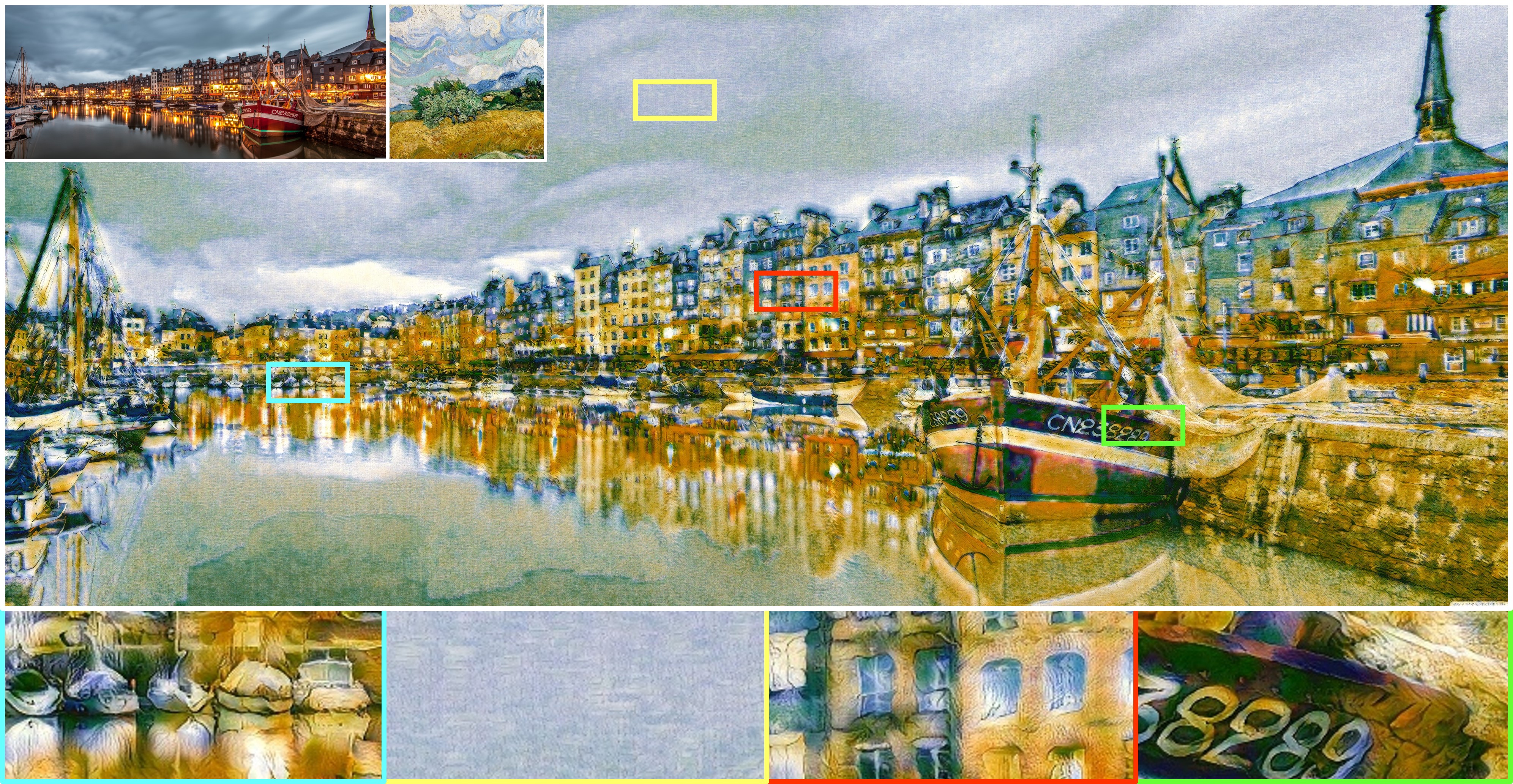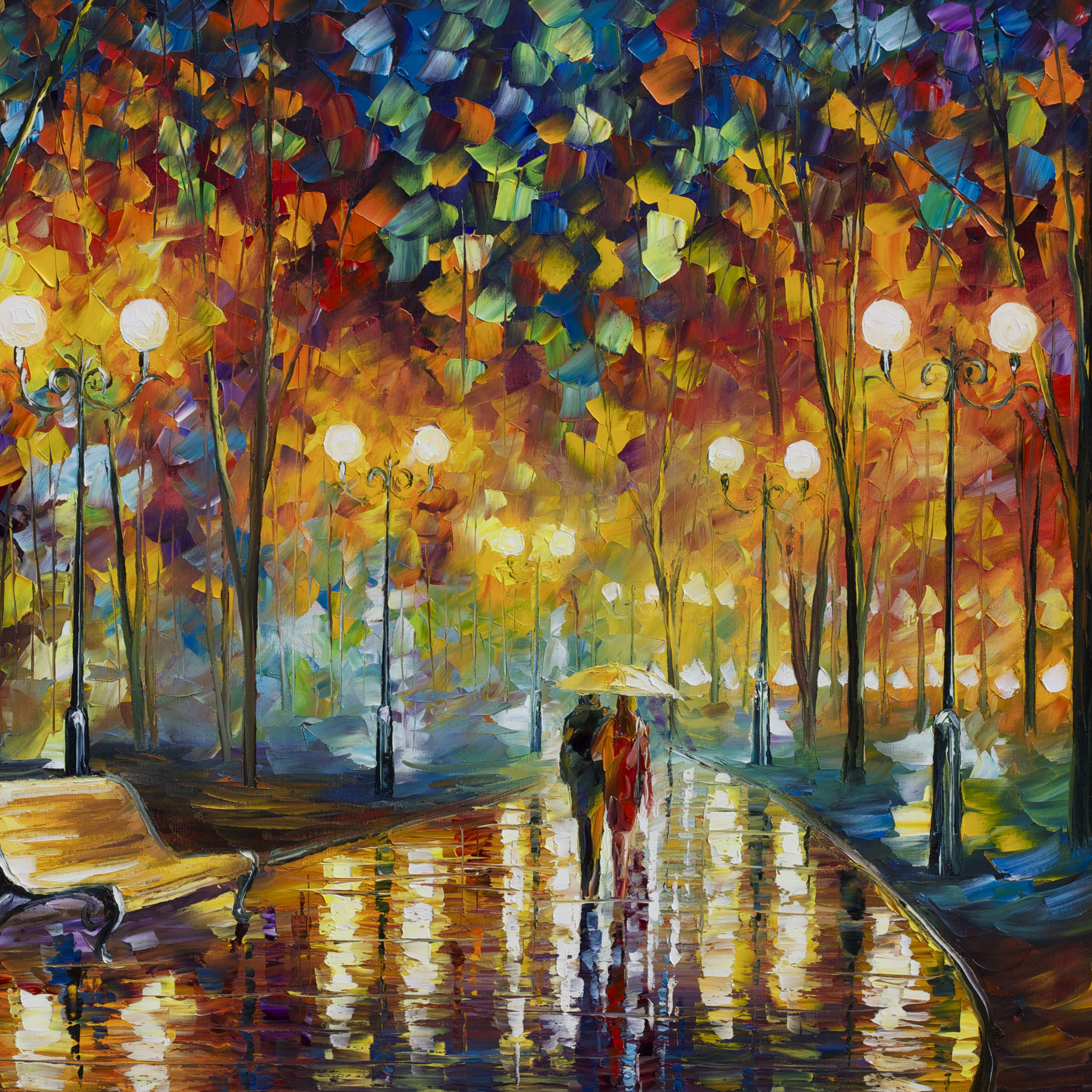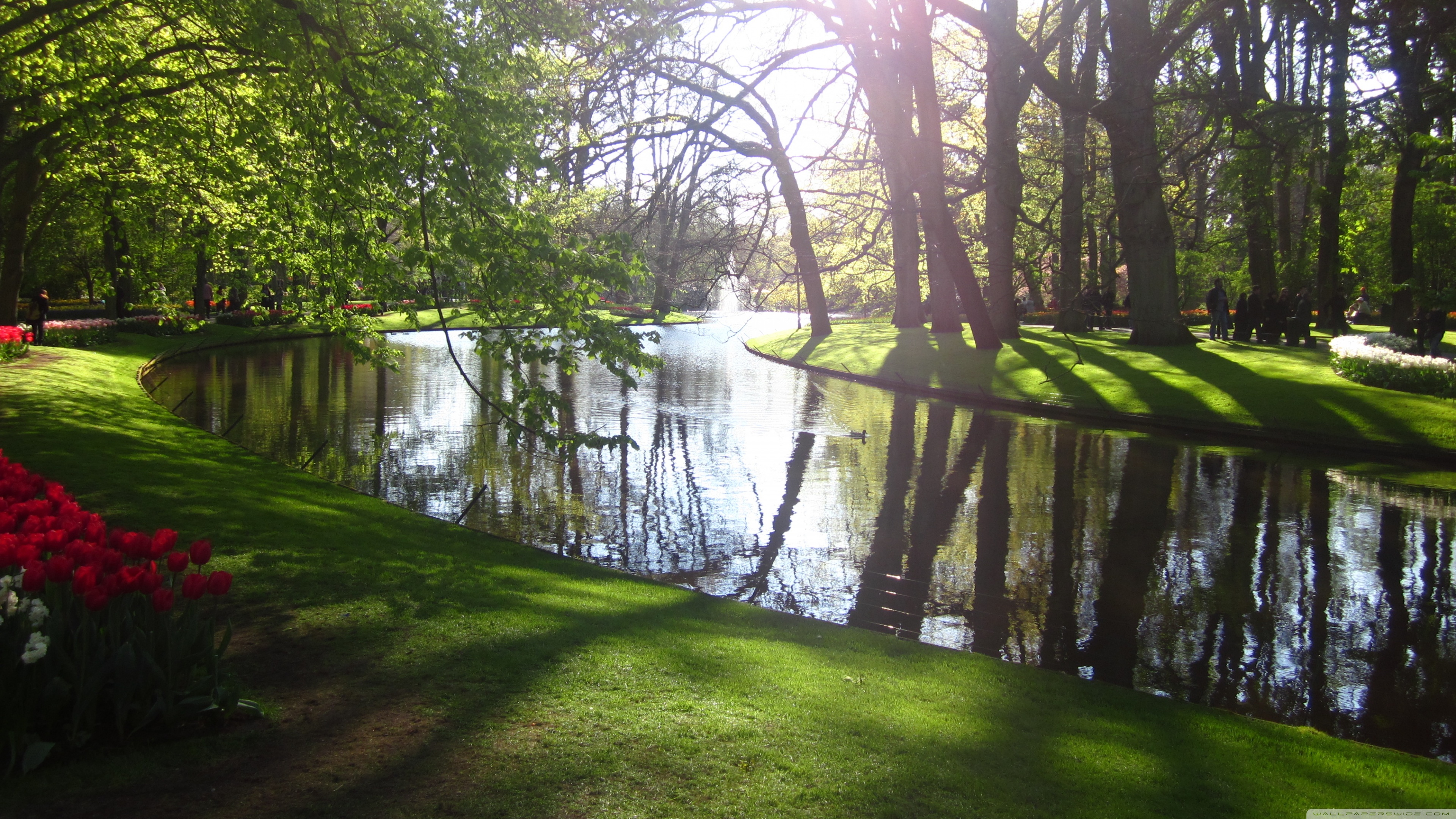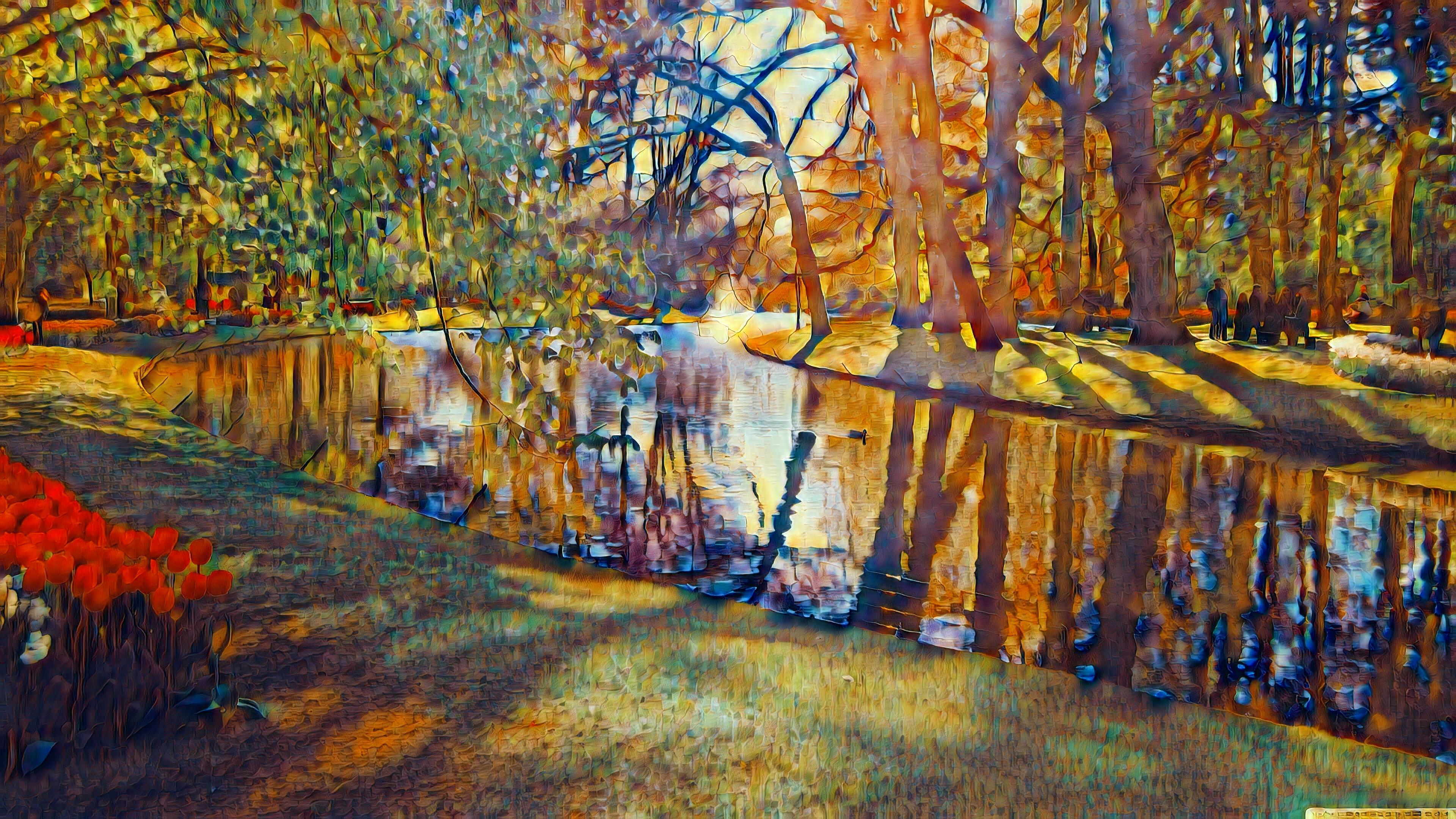Collaborative-Distillation
Official PyTorch code for our CVPR-20 poster paper "Collaborative Distillation for Ultra-Resolution Universal Style Transfer", where we propose a new knowledge distillation method to reduce VGG-19 filters, realizing the ultra-resolution universal style transfer on a single 12GB GPU. We focus on model compression instead of new stylization schemes. For stylization, our method builds upon WCT.
One stylized sample of 10240 x 4096 pixelsEnvironment
- OS: Linux (Ubuntu 1404 and 1604 checked. It should be all right for most linux platforms. Windows and MacOS not checked.)
- python==3.6.9 (conda to manage environment is suggested)
- The needed libraries are summarized in
requirements.txt. Simply install them bypip install -r requirements - CUDA (cuDNN is not necessary)
After the installlations, download the code:
git clone https://github.com/MingSun-Tse/Collaborative-Distillation.git
Test (style transfer)
Step 1: Prepare images
- Contents are placed in
PytorchWCT/content, where ultra-res contents are placed inPytorchWCT/content/UHD_content. Same path setting for the styles. - Since the ultra-res images can be quite large, we only place two samples in this repo. For more ultra-res contents and styles presented in our paper, please download them from this google drive.
Image copyrights: We use the UHD images from this wallpaper website. All copyrights are attributed to them and thanks to them!
Step 2: Prepare models
- For original WCT: Download the unpruned models (which are from the official WCT implementation). Unzip and place them under
trained_models/original_wct_models. - For ultra-resolution WCT: We use our pruned VGG-19. The models are already in the
trained_models/wct_se_16x_new(for encoders) andtrained_models/wct_se_16x_new_sd(for decoders).
Step 3: Stylization
- Under the
PytorchWCTfolder, please run the following scripts. The stylized results will be saved inPytorchWCT/stylized_results.
# use original VGG-19, normal images
CUDA_VISIBLE_DEVICES=0 python WCT.py --debug --mode original
# use original VGG-19, ultra-res images
CUDA_VISIBLE_DEVICES=0 python WCT.py --debug --mode original --UHD
# use our pruned VGG-19, normal images
CUDA_VISIBLE_DEVICES=0 python WCT.py --debug --mode 16x
# use our pruned VGG-19, ultra-res images
CUDA_VISIBLE_DEVICES=0 python WCT.py --debug --mode 16x --UHD
# If your RAM cannot afford some large images, you can change the content and style size via '--content_size' and '--style_size'
CUDA_VISIBLE_DEVICES=0 python WCT.py --debug --mode 16x --UHD --content_size 3000 --style_size 2000
In default, the above scripts will test all possible content-style combinations (i.e., for 3 contents with 4 styles, there will be 3x4 stylized results). If you only want to test a specific pair, say, content "green_park-wallpaper-3840x2160.jpg" with style "Vincent_2K.jpg", you can use the option --picked_content_mark and --picked_style_mark to select specific pairs. E.g., the following will only choose the content whose name includes "green_park" and the style whose name includes "Vincent".
CUDA_VISIBLE_DEVICES=0 python WCT.py --debug --mode 16x --UHD --picked_content_mark green_park --picked_style_mark Vincent
Train (model compression)
Step 1: Prepare dataset
Download the MS-COCO 2014 training set and unzip it at path data/COCO/train2014.
Step 2: Prepare models
For training the SE (small encoder), we need the original decoder (big decoder or BD). We trained our own BD following the WCT paper. You can download them from this google drive and put them at path trained_models/our_BD.
Step 3: Train the compressed encoders
Under the root folder, run
CUDA_VISIBLE_DEVICES=0 python main.py --mode wct_se --pretrained_init --screen --stage 5 -p wct_se_stage5
CUDA_VISIBLE_DEVICES=0 python main.py --mode wct_se --pretrained_init --screen --stage 4 -p wct_se_stage4
CUDA_VISIBLE_DEVICES=0 python main.py --mode wct_se --pretrained_init --screen --stage 3 -p wct_se_stage3
CUDA_VISIBLE_DEVICES=0 python main.py --mode wct_se --pretrained_init --screen --stage 2 -p wct_se_stage2
CUDA_VISIBLE_DEVICES=0 python main.py --mode wct_se --pretrained_init --screen --stage 1 -p wct_se_stage1
- The log and trained models will be saved in a new-built project folder under
Experiments. --pretrained_initis to indicate using base models for initialization, which are obtained by pruning the filters with the least L1-norms (see also 2017-ICLR-Filter Pruning)
Step 4: Train the corresponding decoders
CUDA_VISIBLE_DEVICES=0 python main.py --mode wct_sd --pretrained_init --screen --lw_perc 0.01 --stage 5 -p wct_sd_stage5 --SE <SE path>
CUDA_VISIBLE_DEVICES=0 python main.py --mode wct_sd --pretrained_init --screen --lw_perc 0.01 --stage 4 -p wct_sd_stage4 --SE <SE path>
CUDA_VISIBLE_DEVICES=0 python main.py --mode wct_sd --pretrained_init --screen --lw_perc 0.01 --stage 3 -p wct_sd_stage3 --SE <SE path>
CUDA_VISIBLE_DEVICES=0 python main.py --mode wct_sd --pretrained_init --screen --lw_perc 0.01 --stage 2 -p wct_sd_stage2 --SE <SE path>
CUDA_VISIBLE_DEVICES=0 python main.py --mode wct_sd --pretrained_init --screen --lw_perc 0.01 --stage 1 -p wct_sd_stage1 --SE <SE path>
<SE path>is to specify the small encoder model trained in Step 3. A path example for stage5 isExperiments/*wct_se_stage5*/weights/*.pth
Results
Acknowledgments
In this code we refer to the following implementations: PytorchWCT, UniversalStyleTransfer, pytorch-AdaIN, AdaIN-style. Great thanks to them!
Reference
Please cite this in your publication if our work helps your research. Should you have any questions, welcome to reach out to Huan Wang (wang.huan@northeastern.edu).
@inproceedings{wang2020collaborative,
Author = {Wang, Huan and Li, Yijun and Wang, Yuehai and Hu, Haoji and Yang, Ming-Hsuan},
Title = {Collaborative Distillation for Ultra-Resolution Universal Style Transfer},
Booktitle = {Proceedings of the IEEE Conference on Computer Vision and Pattern Recognition (CVPR)},
Year = {2020}
}



